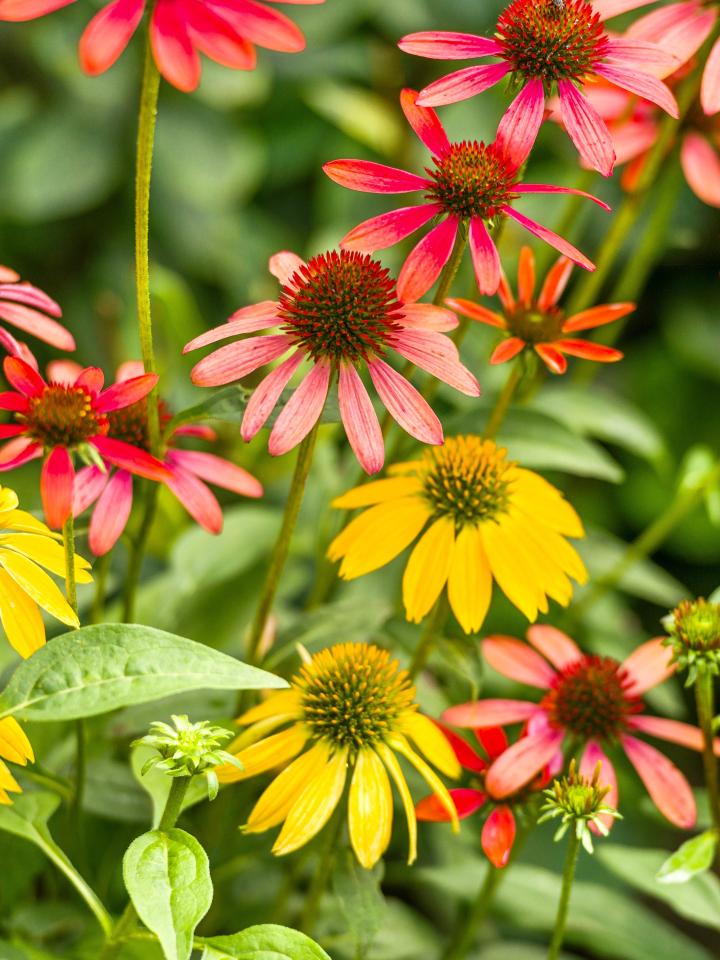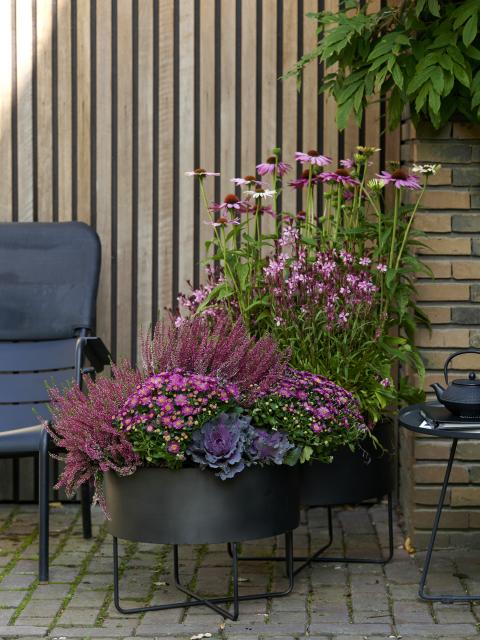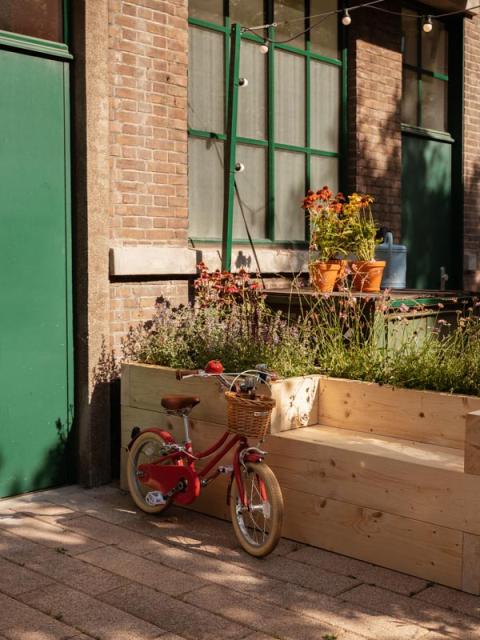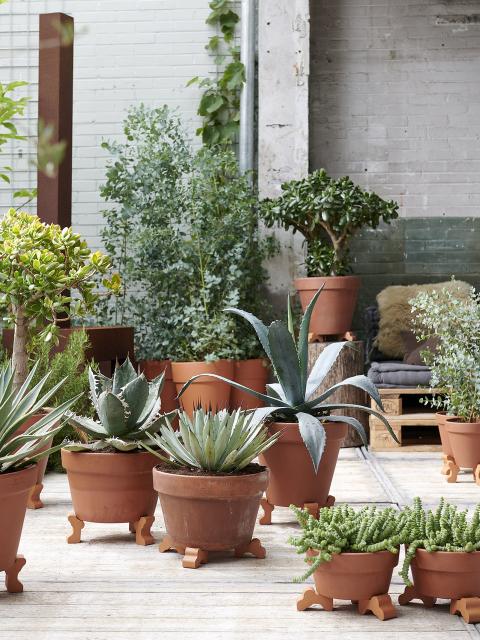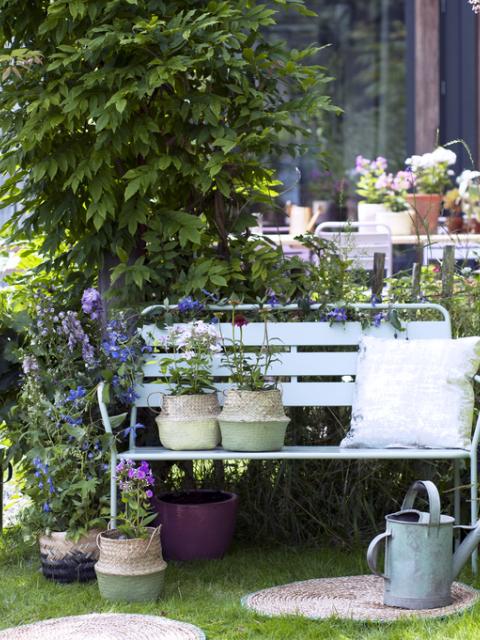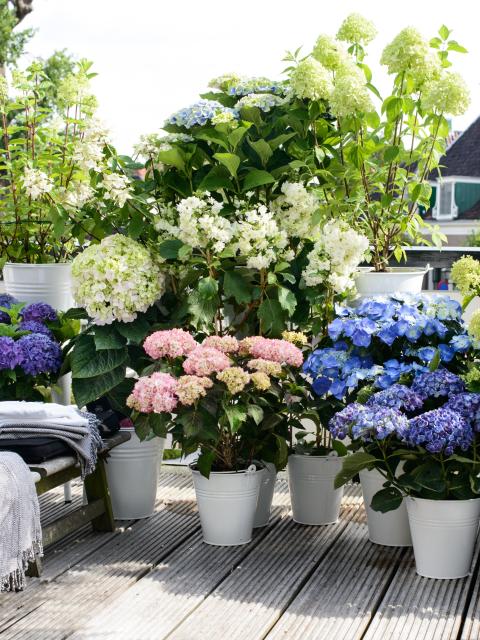Characteristics and flowering period
Echinacea is a popular and attractive garden plant and cut flower. It can be recognised by its long stems and striking flowers with a tall centre that rises far above the flower itself.
Echinacea is an herbaceous plant from the aster family (Asteraceae), which includes plants such as sunflower, daisy and aster. Echinacea is an easy-to-care-for plant, can withstand a little drought and grows about 60-100 centimetres tall. The archetype is Echinacea purpurea, which gets its name from its purple-coloured petals. Today, due to breeding, there is much more choice in colour, shape and variety, ranging from soft yellow to purple, salmon-coloured to white and orange to green, with single-flowered and double-flowered varieties.
Echinacea blooms from July to September and the flowering period lasts about 6-8 weeks. Echinacea looks lovely in a vase and can even be dried. This flower also contributes positively to biodiversity, producing a honey-like scent that attracts bees, butterflies and other insects.
Echinacea species
There are several species of Echinacea, each with unique characteristics. The plant is often distinguished by its colour (e.g. ‘red Echinacea’, ‘white Echinacea’ and ‘yellow Echinacea’, but these are not official species. Here are the most common species of Echinacea:
- Echinacea purpurea: this is the most well-known species of Echinacea. It can be recognised by its large flowers and a distinctive, orange-brown centre. The petals are lanceolate and somewhat droopy. Originally purple, the colours of this species today range from purple and pink to red, white and yellow.
- Echinacea angustifolia: this species has smaller flowers than Echinacea purpurea. The flowers are often pink or purple in colour and have a distinctive brown centre. The petals are narrow and are usually slightly straighter than those of Echinacea purpurea.
- Echinacea pallida: this species has longer, narrower petals that are often pale pink in colour and a little further apart. Echinacea pallida has a distinctive, brownish-red heart.
- Echinacea tennesseensis: this species has orange-pink flowers. The petals are somewhat wider and closer together than those of the other species. Echinacea tennesseensis grows lower to the ground than the other species (about 60 centimetres high, where the above species can reach about 80-90 centimetres).
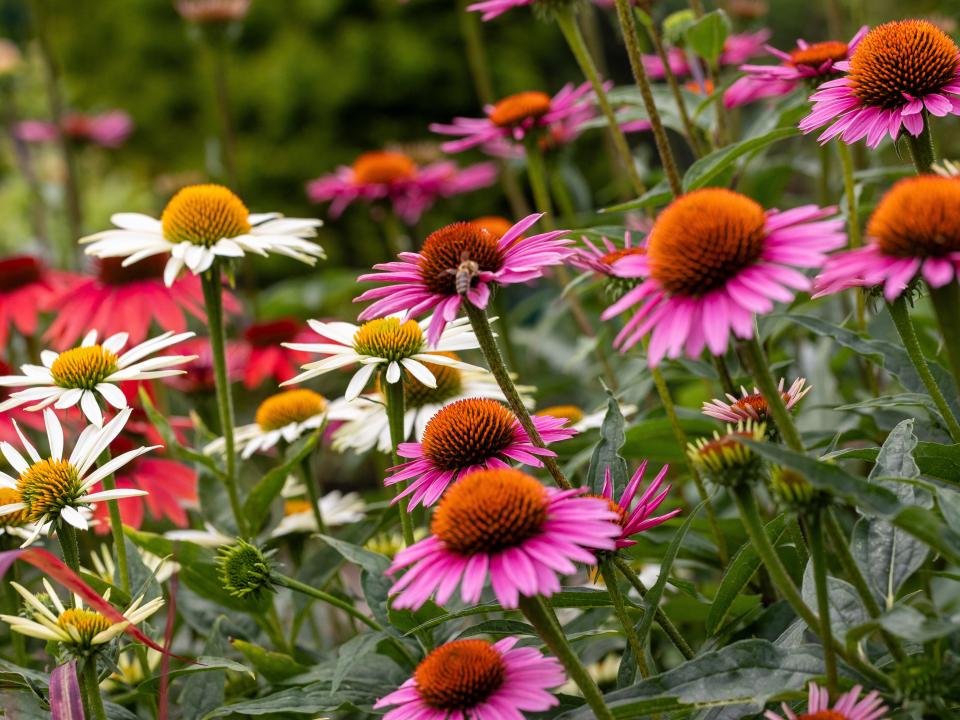
Where does the name echinacea come from?
Echinacea is derived from the Greek word ‘ekhinos’, meaning ‘hedgehog’, because the flower's distinctive, spiny heart is reminiscent of a hedgehog's spines.
How and when you should sow and plantEchinacea
You can easily sow Echinacea yourself. The plant then self-propagates, making it grow bigger and bigger. Preferably, you should sow the plant in the autumn, when the soil is still warm from summer and gets plenty of autumn rain.
You don't need to sow Echinacea deeply. Cover the seeds with a thin layer of soil. Sow in moderation, otherwise the small plants will grow too close together. Preferably leave about 30-40 centimetres between the young plants, and thin them out if necessary.
Planting Echinacea in your garden? You can do either in spring or autumn (not in a frost-filled time period). Check out the best tips and step-by-step plans for planting garden plants here.
Echinacea: location and care
Planting Echinacea in your garden or on your balcony? Check out the tips below for the best location and caretaking advice:
- Echinacea thrives best in a warm spot in full sun or semi-shade.
- Calcareous, humus-rich, well-drained soil will work best.
- Echinacea doesn't like heavy, wet, clay-rich soil.
- Echinacea is an easy plant that doesn't need much nutrition. Poor, sandy soil can be fertilised with organic fertiliser in spring, if necessary.
- Echinacea plants can grow quite tall and self-seed, so give them some space wherever they're planted.
- Although the plant grows quite tall, you don't need to support or guide it. The stems are sturdy and can take a beating.
- Snails love Echinacea, so put some coffee grounds around the base if necessary or fight snails in another environmentally friendly way.
- Echinacea can tolerate drought well, but water the plant during longer, hot and dry periods.
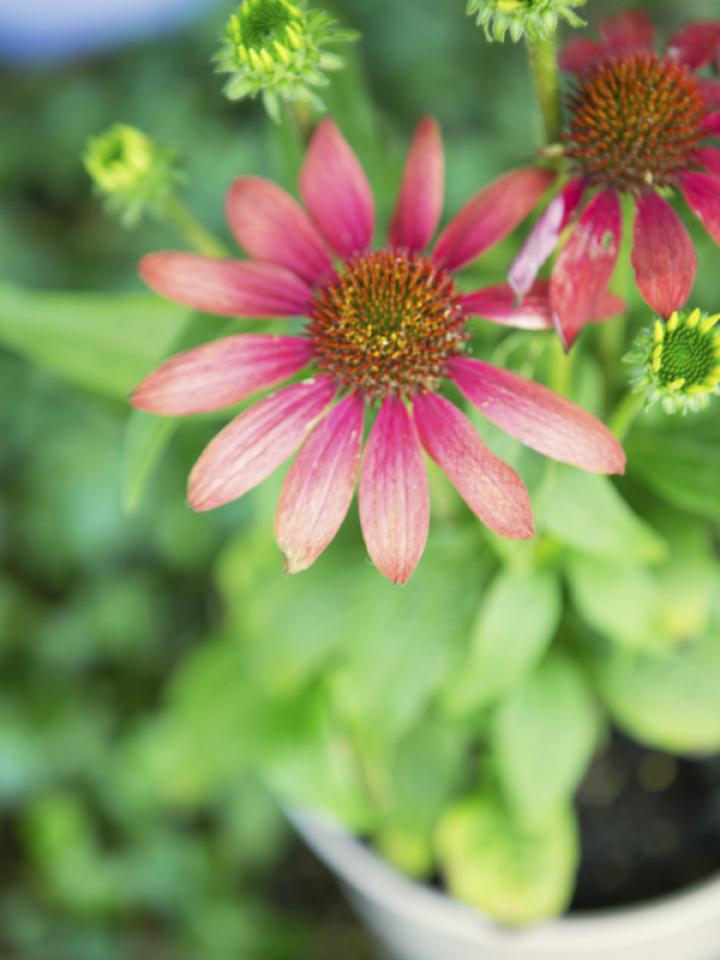
How and when should you prune Echinacea?
Many species of Echinacea can flower a second time in a single year. Therefore, remove spent flower stems just above a side shoot to encourage a second flowering and enjoy your Echinacea even longer. After this second bloom is over, you can:
- You do nothing and prune only in spring: leave all spent flower stems on the plant. This way, the plant can sow itself, which means you will have more Echinaceas in your garden next year. Moreover, birds love the seeds left behind!
- You thin out the plant in autumn and prune the rest in spring: you can prune some flower stems to just above the ground. This ensures that you thin out the plant and that it doesn't spread out too much. By leaving some stems in place, the birds (and you) can still enjoy during winter. If you choose this option, prune your Echinacea back completely in the spring, which will allow it to sprout up again by itself and to flower beautifully in summer.
- You prune the plant completely in autumn: you can prune Echinaceas completely immediately after flowering (around the end of September). Remove all spent stems to about 15 centimetres above the ground. Note: this option is not preferred, as it will lose its decorative value and birds will no longer be able to pick seeds from it.
Echinacea is hardy, not evergreen
Echinacea is hardy to around -20°C, which means that in most climates the plant can survive the winter just fine without needing protection. However, this is not evergreen, meaning that it dies above ground in winter. The roots remain active and the plant sprouts on its own in spring.
How to take cuttings and propagate Echinacea
Do you want to propagate Echinacea? The plant sows itself if you leave the spent flowers, but if you want to propagate the plant by dividing it, you can do that too, preferably in spring or autumn (not during the flowering season). See more information and the step-by-step plan for dividing a plant here.
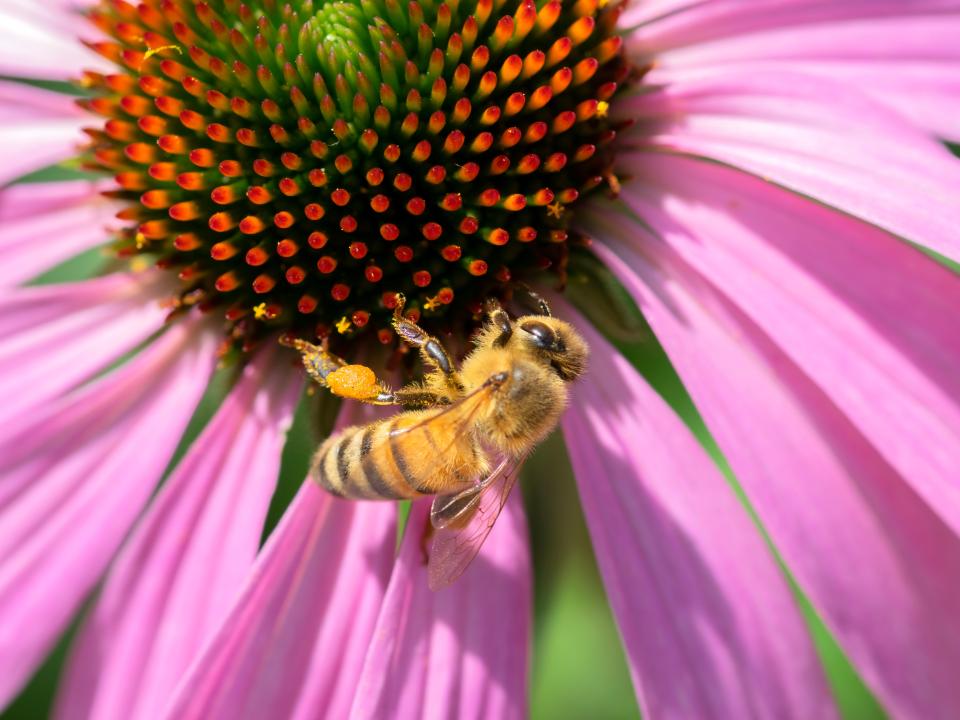
Echinacea origins
Originally Echinacea came from North America, where it grew on the dry prairies of the southern states. Later, the plant also appeared in the deciduous forests of the western and central United States. Native Americans used the plant for centuries to fight infections. In the 17th century, the plant was discovered by European explorers and botanists, who popularised its benefits and the plant's popularity grew fast. Today, Echinacea is a very popular border plant, although in recent years it's also increasingly seen as a container plant.
Is Echinacea poisonous?
No, Echinacea is not poisonous. The flowers and leaves of the plant are safe for humans and animals including dogs and cats. This plant is used in herbal medicines and teas because of its supposed health benefits. Note that although this plant isn't poisonous, we don't recommend consuming it when it hasn't been sourced from a specialised supplier that grows it for consumption.
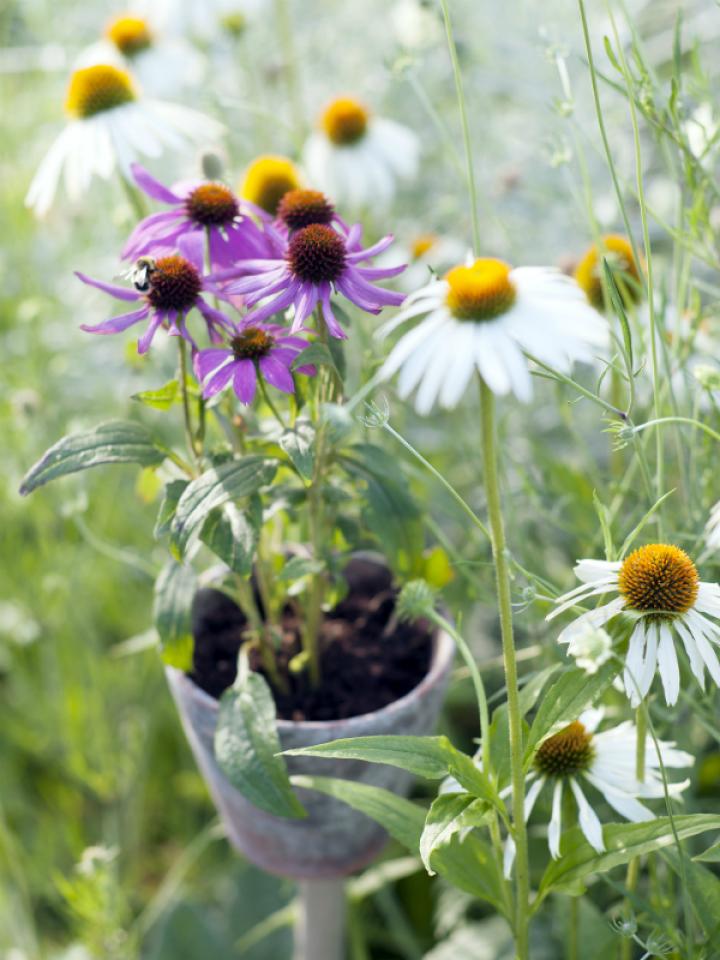
Health benefits of echinacea
Echinacea has been valued for its health benefits for centuries. The plant, particularly Echinacea purpurea, is used in both traditional and modern medicine. In the past, the plant was used for a wide range of conditions, such as for soothing pain after insect bites, treating infections, reducing inflammation and supporting the immune system.
Today, Echinacea is mainly used to support the immune system and reduce the severity and duration of colds and flu (via the medium of capsules and tablets). Echinacea is also used as an anti-inflammatory ingredient and Echinacea extract is added to skin care products, as it can help to soothe the skin, reduce inflammation and heal wounds. In addition, Echinacea tea is popular for benefitting the immune system.
Echinaceasymbolism
Echinacea symbolises protection and healing, thanks to its benefits discussed above. The prickly shape of the flower heart is often seen as protection from disease and evil.

